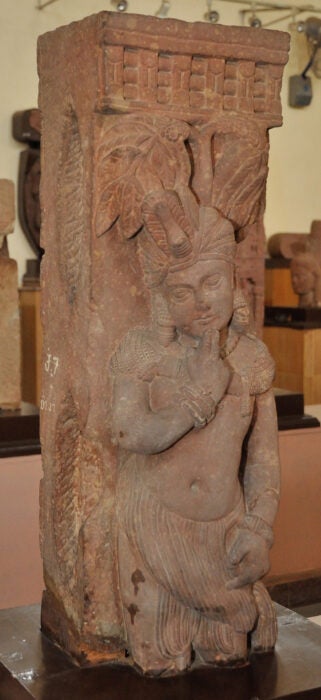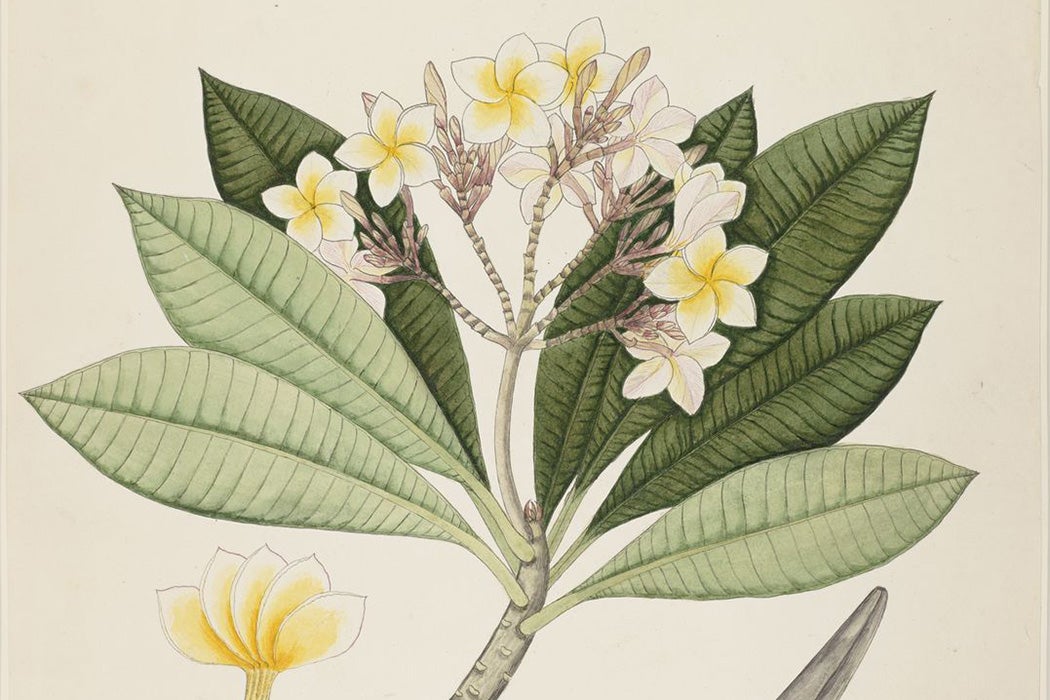Most people are familiar with the scent of Frangipani, a plant typically associated with Southeast Asia. Sometimes confused with Jasmine, Frangipani’s fragrance is decadently sweet, floral, and evocative of other tropical scents such as coconut. It’s widely used to manufacture soaps, perfumes, and essential oil blends. In fact, a recent study estimated that the frangipani extract market is expected to grow to US$ 56 Million by 2032. This comes as frangipani’s anti-inflammatory properties, rich antioxidants, and calming scent make it a popular choice in cosmetic, aromatherapy, and household products.
But beyond its contemporary uses and cultural and geographical associations, Frangipani invites us to take a closer look at the names we use for plants: what they conceal, reveal, and evoke. From its religious significance in Southeast Asia to its branding as an exotic “Oriental” fragrance, and from its origins in America to the numerous confusions surrounding its identification, Frangipani exemplifies the shifting roads that plants can take and how their histories of movement and naming can reflect such trajectories.
Colloquially known as Frangipani, the genus Plumeria has at least twelve scientifically accepted species, many of which can mix together. The trees are known for their large, sweet-smelling flowers, which can come in colors from deep red to pale pink or even white and yellow. These flowers cause their thick succulent branches to divide after flowering by growing at the tip. Frangipani grows well in warm, tropical climates and thrives with plenty of heat, moisture, and good drainage—which explains why Frangipani found a stable home in Southeast Asia. As a member of the family Apocynaceae, its latex is poisonous, and extra care must be taken when preparing cuttings.
One of the most famous species is the ornamental tree Plumeria acuminata, widely known for its white flowers with creamy yellow centers. It can be found in graveyards and temples in India, Thailand, Cambodia, Vietnam, and Indonesia, among other countries. Its importance in Southeast Asia is closely linked to its role in religious ceremonies. Apart from decorating temple grounds, its flowers are ritual offerings in Buddhist and Hindu practices. It’s considered a symbol of immortality because it can flower and produce leaves even if uprooted, facilitating propagation through cuttings. In popular culture and local folklore, Frangipani’s strong fragrance is associated with the arrival of the Malaysian Pontianak or the Filipino Aswang—the vampiric ghost of a beautiful woman who died during childbirth. Its religious and cultural significance is so prominent that Buddhist countries like Laos have claimed Frangipani as their national flower.

Frangipani is also a medicinal plant. In Myanmar, its poisonous sap is used as a laxative and counteracts stomach aches and bloating. Its leaves and flowers can be boiled and eaten to make salads that help the digestive and urinary tracts. Similar medicinal uses have been noted in India, China, Indonesia, the Philippines, and Palau.
But despite its cultural significance in Southeast Asia, Frangipani comes from tropical America. In fact, Frangipani’s scientific name, Plumeria, was originally coined in 1700 in honor of Charles Plumier, the “Father of West Indian Flora.” Plumier was a monk, botanist, and draughtsperson who was well known for his extensive drawings and documentation from his expeditions to the West Indies and Central America. These were commissioned by the French crown and were part of a larger pattern of botanical imperialism that linked the study of nature to political power and territorial expansion. The movement of plants and botanical knowledge was closely linked to colonial powers and served to sustain and enrich them economically.
Frangipani’s arrival in Southeast Asia, though, has intrigued many disciplines, including botany, art history, and philology. Before Carl Linnaeus’s binomial nomenclature was adopted, many names were used to describe the same plants based on non-standardized characteristics such as supposed origin and physical shape. Thus, it can be difficult to distinguish plants just by their colloquial names, especially when looking at historical records. There’s strong evidence that it was introduced by the Spanish through their extensive colonial networks, although it’s unclear whether the plant arrived from the East or the West.
Some sources link the plant’s native Mexico to the Philippines. In his seventeenth-century work on Filipino flora, local botanist Ignacio de Mercado Morales writes that Frangipani (albeit under the name Calachuche, a variant of the Nahuatl kalachuchl) was extremely widespread and came from “la Neuva Espalia,” or “the New Spain” (present-day Mexico). This hypothesis is supported by Morales’s own familiarity with the region’s flora, and it was reinforced by botanists such as the Jesuit Georg Josef Camel SJ, who names the plant Cacaloxochitl Mexicana in his Descriptiones Fruticum et Arborum Luzonis (1704). Moreover, drawing on philology, botanist E. D. Merrill examined the names used for Plumeria species worldwide and concluded that many of them were, in many cases, derivatives of Mexican variants.

But there has been confusion around the presence of Frangipani in Southeast Asian history. In Mathura, an Indian city sacred in Hindu and Buddhist histories, a stone panel of the legend Rishyasringa dating back to the second century BC allegedly depicts Plumeria Acuminata. Historian Shakti M. Gupta notes that the plant’s “prominent dichotomous branching, elliptical leaves and bunches of flowers” are all present in this ancient artwork. Similarly, researchers have identified the Plumeria Acuminata in the bas reliefs that adorn the walls of the Borobudur Temple in Java, dating back to the twelfth century. Because Frangipani is non-native to Southeast Asia, experts have proposed that these could have been the Magnolia Champace (Michelia champaca), Pinwheel Flower (Tabernaemontana divaricata), or Orange Jessamine (Murraya paniculata) that were all growing in the region at the time of construction according to Merrill. These plants feature highly fragrant white flowers, some of which look almost identical to that of the Frangipani. Just as with naming, pictorial depictions of plants can lead to difficulties in identification, especially when many physical characteristics find parallels across species.
The English common name Frangipani also has a mystery flavor to it, albeit one artificially produced by commerce and advertising. It’s thought to come from the French word for Frangipani—frangipanier. French botanists linked its scent to perfume frangipane, a popular almond perfume for gloves manufactured by the nobleman Marquis Muzio de Frangipani in the seventeenth century. In the nineteenth century, a group of perfumers in London further added to this confusion. To promote their fragrances, they created the myth of “Mercutio Frangipane,” a fictional botanist associated with Columbus’s travels to the New World who made sensational discoveries through his sense of smell. Aimed at driving up profits, this marketing move drew upon racially-charged notions of Orientalism, linking the native tropical habitat of the plant to the idea of a distant “Other” to invest the fragrance with a sense of adventure and exoticism.
Even in the twentieth century, these legacies of exoticization can be seen in Western descriptions of the plant. In the Coolidge Rare Plant Garden catalog (1924), the genus Plumeria is described as “The Frangipani of the tropics. A most chaste and beautiful flowering plant whose flowers are exquisitely perfumed. Very tender.” The descriptions of “chaste” and “tender” associate the flower’s scent with notions of sensuality and femininity, a trope that stems from nineteenth-century Western ideas that parallel the delicacy of flowers to the innocence of a young girl. This reductive gaze fits into larger patterns of depicting Asia as not only effeminate but sexualized, as often found in nineteenth-century depictions of harems and promiscuous women. For example, a print by Belgium artist Félicien Rops, titled La Fleur Lascive, explicitly relates flowers to Orientalist notions of lasciviousness. These erotic depictions reduce different geographies and regions under the blanket notion of the sexual Oriental “Other.”

This relationship between flowers and Orientalism extends to fragrances as well. French writers working in the 1800s identified the stereotypical “Oriental” woman by her sensuous scent, and florals were associated with femininity. This harmful legacy has carried on to the twenty-first century, when supposed Oriental imagery in perfume advertisements conveys a sense of eroticism, mystery, and submissiveness.
Weekly Newsletter
Contrary to this reductive Western use of Eastern fragrances, the role of florals is particularly important in Southeast Asian cultures. The aroma of flowers, like that of Frangipani, is a key religious symbol in literature and rituals and is closely connected with the presence and nature of the Buddha. In rituals, the choice of fragrance is not only an act of devotion but also an expression of the divine being’s aesthetic preferences, thus creating a connection with the worshipper. “Smell” is also a unique sense in Buddhist thought as it allows for interaction with the actual particles of an object even from a distance—a way for gods to appreciate flowers. The distinctly sweet smell of Frangipani takes on a special religious significance here.
With a rich history that charts colonial networks, ancient temple art, Orientalist depictions, and confusing names, the status of Frangipani as a cultural, national, and religious symbol guarantees that new stories will continue to emerge around it. Frangipani also shows that attempting to trace the history of just one plant species often spans many centuries, countries, and fields of study. This is why the Plant Humanities Initiative at Dumbarton Oaks brings together different approaches to expand our understanding of how plants and humans shape each other’s lives.
Support JSTOR Daily! Join our new membership program on Patreon today.








